ACCT 2060 - GoLite: Stakeholder Analysis and Balanced Scorecard S2
VerifiedAdded on 2023/06/08
|9
|2355
|182
Case Study
AI Summary
This assignment provides a comprehensive analysis of GoLite, focusing on its stakeholders and the application of the Balanced Scorecard (BSC) framework. It identifies the five main stakeholder groups: customers, employees, business partners, local communities, and shareholders, detailing their potential decisions and the externalities impacting them. The assignment further explores different types of accounts relevant to each stakeholder. It discusses the Balanced Scorecard as a management tool for GoLite, incorporating financial, customer, internal process, learning and growth, environmental, and social perspectives. Finally, it proposes performance metrics for each perspective, such as sales growth, customer satisfaction, material turnover, employee retention, energy utilization, and standard of living, providing a robust framework for evaluating GoLite's performance and sustainability.

GoLite
1
1
Paraphrase This Document
Need a fresh take? Get an instant paraphrase of this document with our AI Paraphraser
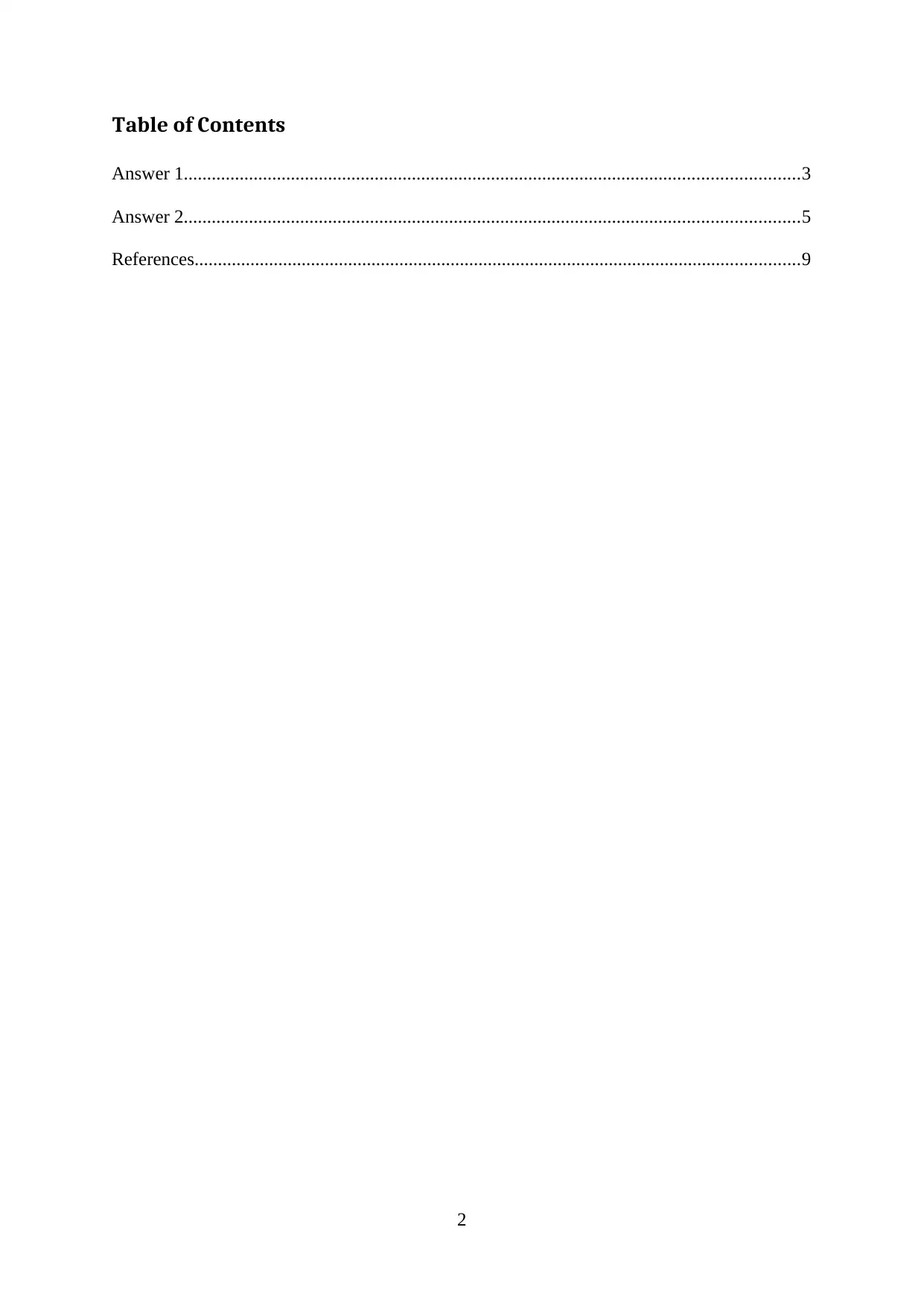
Table of Contents
Answer 1....................................................................................................................................3
Answer 2....................................................................................................................................5
References..................................................................................................................................9
2
Answer 1....................................................................................................................................3
Answer 2....................................................................................................................................5
References..................................................................................................................................9
2
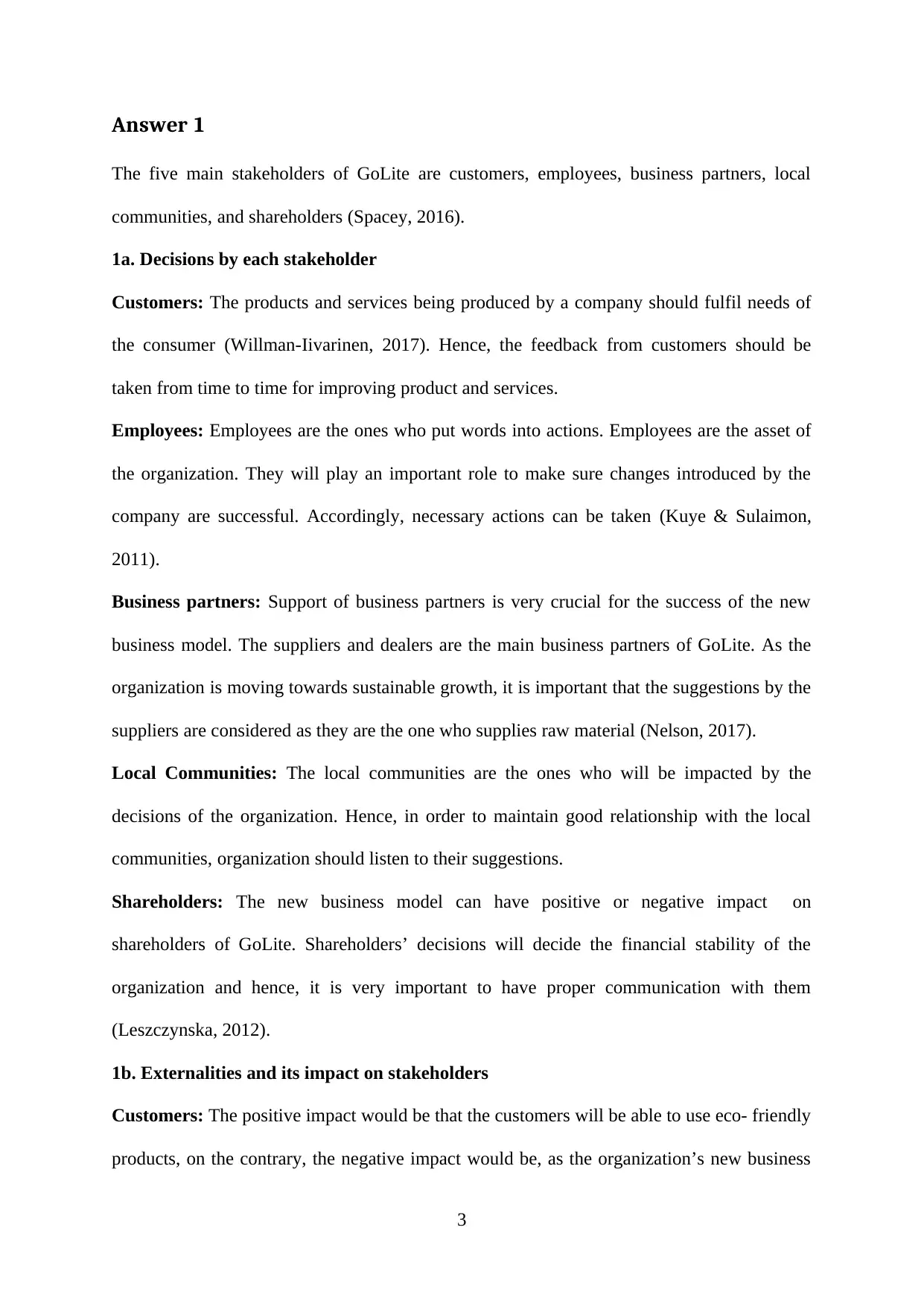
Answer 1
The five main stakeholders of GoLite are customers, employees, business partners, local
communities, and shareholders (Spacey, 2016).
1a. Decisions by each stakeholder
Customers: The products and services being produced by a company should fulfil needs of
the consumer (Willman-Iivarinen, 2017). Hence, the feedback from customers should be
taken from time to time for improving product and services.
Employees: Employees are the ones who put words into actions. Employees are the asset of
the organization. They will play an important role to make sure changes introduced by the
company are successful. Accordingly, necessary actions can be taken (Kuye & Sulaimon,
2011).
Business partners: Support of business partners is very crucial for the success of the new
business model. The suppliers and dealers are the main business partners of GoLite. As the
organization is moving towards sustainable growth, it is important that the suggestions by the
suppliers are considered as they are the one who supplies raw material (Nelson, 2017).
Local Communities: The local communities are the ones who will be impacted by the
decisions of the organization. Hence, in order to maintain good relationship with the local
communities, organization should listen to their suggestions.
Shareholders: The new business model can have positive or negative impact on
shareholders of GoLite. Shareholders’ decisions will decide the financial stability of the
organization and hence, it is very important to have proper communication with them
(Leszczynska, 2012).
1b. Externalities and its impact on stakeholders
Customers: The positive impact would be that the customers will be able to use eco- friendly
products, on the contrary, the negative impact would be, as the organization’s new business
3
The five main stakeholders of GoLite are customers, employees, business partners, local
communities, and shareholders (Spacey, 2016).
1a. Decisions by each stakeholder
Customers: The products and services being produced by a company should fulfil needs of
the consumer (Willman-Iivarinen, 2017). Hence, the feedback from customers should be
taken from time to time for improving product and services.
Employees: Employees are the ones who put words into actions. Employees are the asset of
the organization. They will play an important role to make sure changes introduced by the
company are successful. Accordingly, necessary actions can be taken (Kuye & Sulaimon,
2011).
Business partners: Support of business partners is very crucial for the success of the new
business model. The suppliers and dealers are the main business partners of GoLite. As the
organization is moving towards sustainable growth, it is important that the suggestions by the
suppliers are considered as they are the one who supplies raw material (Nelson, 2017).
Local Communities: The local communities are the ones who will be impacted by the
decisions of the organization. Hence, in order to maintain good relationship with the local
communities, organization should listen to their suggestions.
Shareholders: The new business model can have positive or negative impact on
shareholders of GoLite. Shareholders’ decisions will decide the financial stability of the
organization and hence, it is very important to have proper communication with them
(Leszczynska, 2012).
1b. Externalities and its impact on stakeholders
Customers: The positive impact would be that the customers will be able to use eco- friendly
products, on the contrary, the negative impact would be, as the organization’s new business
3
You're viewing a preview
Unlock full access by subscribing today!
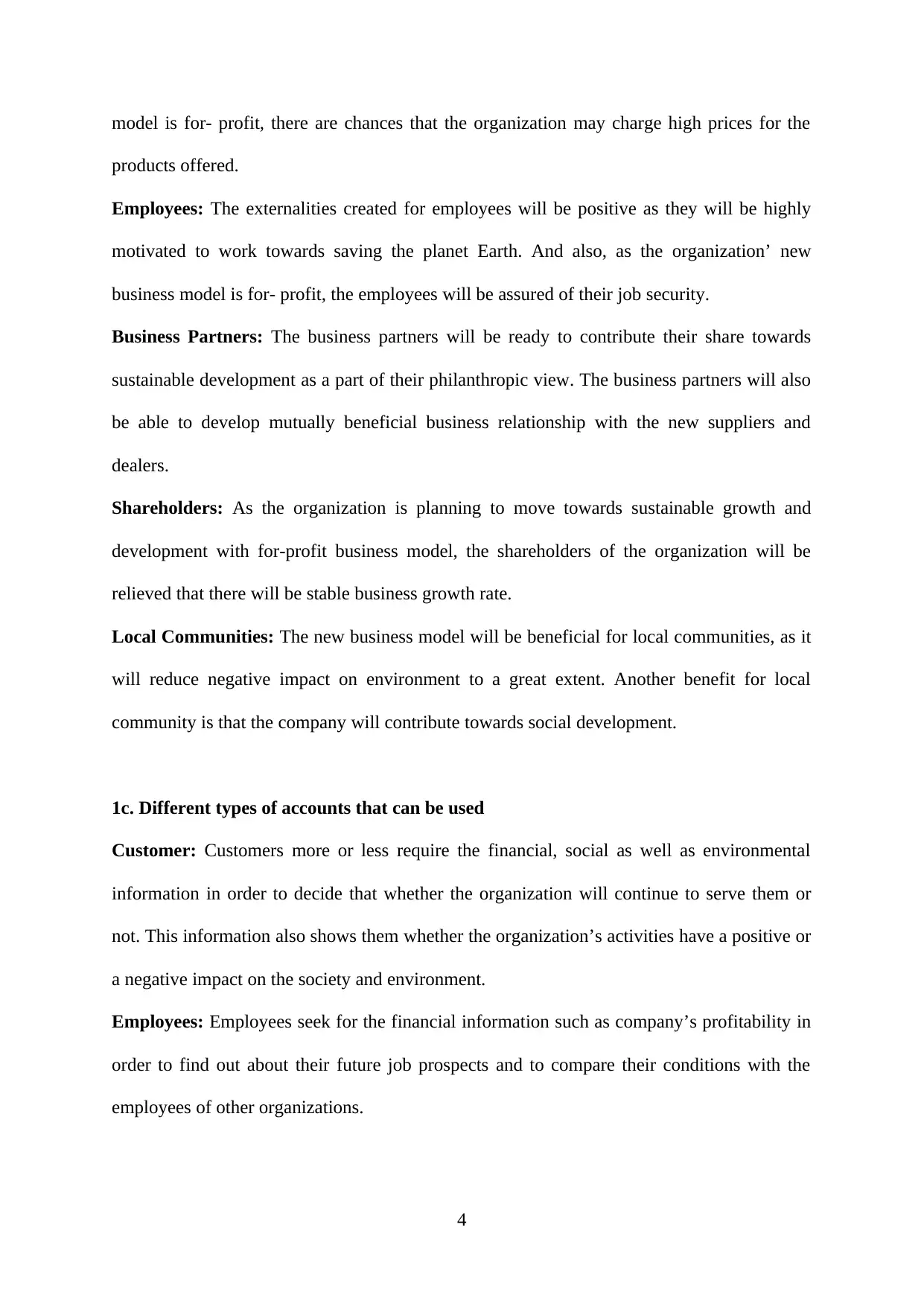
model is for- profit, there are chances that the organization may charge high prices for the
products offered.
Employees: The externalities created for employees will be positive as they will be highly
motivated to work towards saving the planet Earth. And also, as the organization’ new
business model is for- profit, the employees will be assured of their job security.
Business Partners: The business partners will be ready to contribute their share towards
sustainable development as a part of their philanthropic view. The business partners will also
be able to develop mutually beneficial business relationship with the new suppliers and
dealers.
Shareholders: As the organization is planning to move towards sustainable growth and
development with for-profit business model, the shareholders of the organization will be
relieved that there will be stable business growth rate.
Local Communities: The new business model will be beneficial for local communities, as it
will reduce negative impact on environment to a great extent. Another benefit for local
community is that the company will contribute towards social development.
1c. Different types of accounts that can be used
Customer: Customers more or less require the financial, social as well as environmental
information in order to decide that whether the organization will continue to serve them or
not. This information also shows them whether the organization’s activities have a positive or
a negative impact on the society and environment.
Employees: Employees seek for the financial information such as company’s profitability in
order to find out about their future job prospects and to compare their conditions with the
employees of other organizations.
4
products offered.
Employees: The externalities created for employees will be positive as they will be highly
motivated to work towards saving the planet Earth. And also, as the organization’ new
business model is for- profit, the employees will be assured of their job security.
Business Partners: The business partners will be ready to contribute their share towards
sustainable development as a part of their philanthropic view. The business partners will also
be able to develop mutually beneficial business relationship with the new suppliers and
dealers.
Shareholders: As the organization is planning to move towards sustainable growth and
development with for-profit business model, the shareholders of the organization will be
relieved that there will be stable business growth rate.
Local Communities: The new business model will be beneficial for local communities, as it
will reduce negative impact on environment to a great extent. Another benefit for local
community is that the company will contribute towards social development.
1c. Different types of accounts that can be used
Customer: Customers more or less require the financial, social as well as environmental
information in order to decide that whether the organization will continue to serve them or
not. This information also shows them whether the organization’s activities have a positive or
a negative impact on the society and environment.
Employees: Employees seek for the financial information such as company’s profitability in
order to find out about their future job prospects and to compare their conditions with the
employees of other organizations.
4
Paraphrase This Document
Need a fresh take? Get an instant paraphrase of this document with our AI Paraphraser
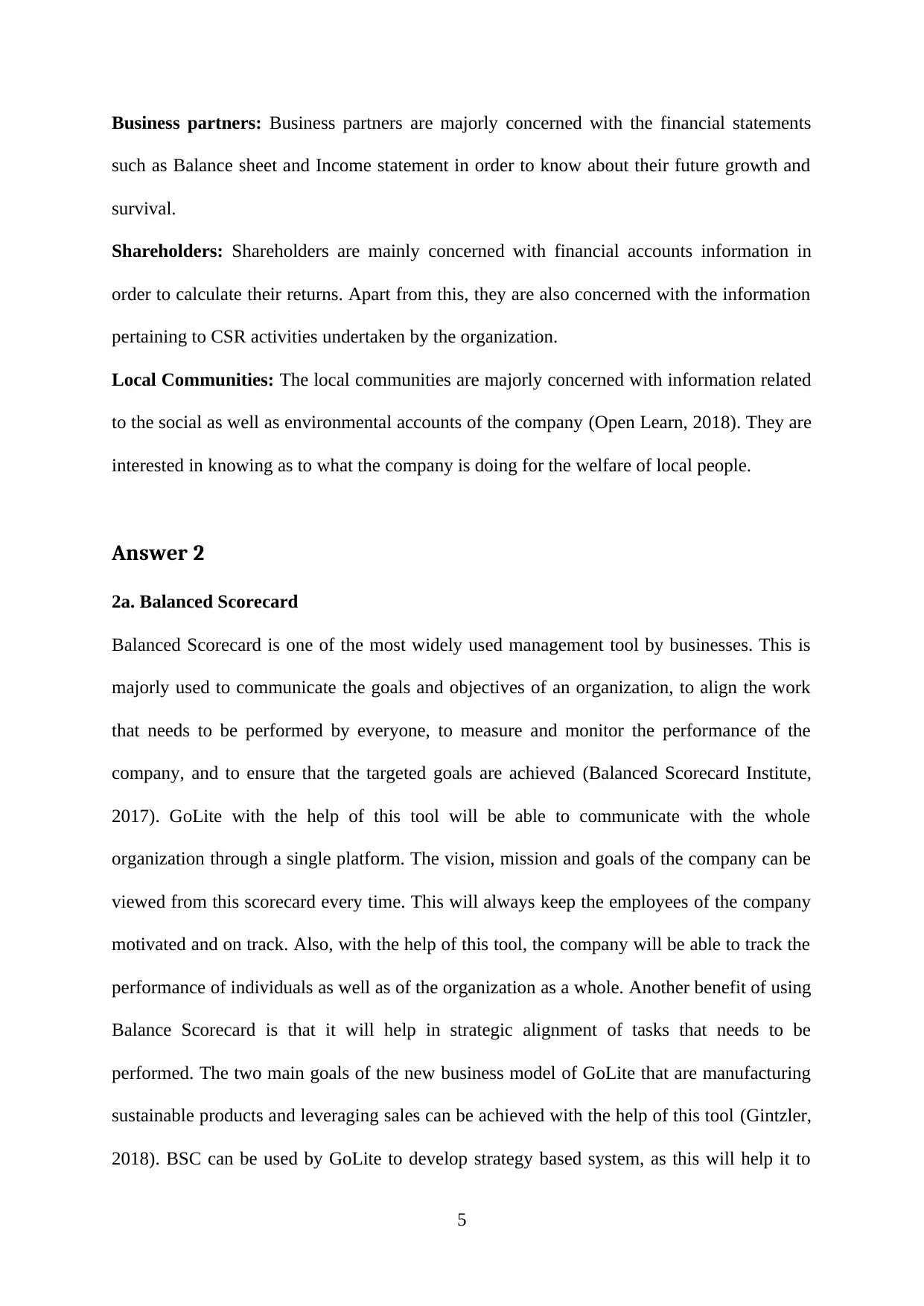
Business partners: Business partners are majorly concerned with the financial statements
such as Balance sheet and Income statement in order to know about their future growth and
survival.
Shareholders: Shareholders are mainly concerned with financial accounts information in
order to calculate their returns. Apart from this, they are also concerned with the information
pertaining to CSR activities undertaken by the organization.
Local Communities: The local communities are majorly concerned with information related
to the social as well as environmental accounts of the company (Open Learn, 2018). They are
interested in knowing as to what the company is doing for the welfare of local people.
Answer 2
2a. Balanced Scorecard
Balanced Scorecard is one of the most widely used management tool by businesses. This is
majorly used to communicate the goals and objectives of an organization, to align the work
that needs to be performed by everyone, to measure and monitor the performance of the
company, and to ensure that the targeted goals are achieved (Balanced Scorecard Institute,
2017). GoLite with the help of this tool will be able to communicate with the whole
organization through a single platform. The vision, mission and goals of the company can be
viewed from this scorecard every time. This will always keep the employees of the company
motivated and on track. Also, with the help of this tool, the company will be able to track the
performance of individuals as well as of the organization as a whole. Another benefit of using
Balance Scorecard is that it will help in strategic alignment of tasks that needs to be
performed. The two main goals of the new business model of GoLite that are manufacturing
sustainable products and leveraging sales can be achieved with the help of this tool (Gintzler,
2018). BSC can be used by GoLite to develop strategy based system, as this will help it to
5
such as Balance sheet and Income statement in order to know about their future growth and
survival.
Shareholders: Shareholders are mainly concerned with financial accounts information in
order to calculate their returns. Apart from this, they are also concerned with the information
pertaining to CSR activities undertaken by the organization.
Local Communities: The local communities are majorly concerned with information related
to the social as well as environmental accounts of the company (Open Learn, 2018). They are
interested in knowing as to what the company is doing for the welfare of local people.
Answer 2
2a. Balanced Scorecard
Balanced Scorecard is one of the most widely used management tool by businesses. This is
majorly used to communicate the goals and objectives of an organization, to align the work
that needs to be performed by everyone, to measure and monitor the performance of the
company, and to ensure that the targeted goals are achieved (Balanced Scorecard Institute,
2017). GoLite with the help of this tool will be able to communicate with the whole
organization through a single platform. The vision, mission and goals of the company can be
viewed from this scorecard every time. This will always keep the employees of the company
motivated and on track. Also, with the help of this tool, the company will be able to track the
performance of individuals as well as of the organization as a whole. Another benefit of using
Balance Scorecard is that it will help in strategic alignment of tasks that needs to be
performed. The two main goals of the new business model of GoLite that are manufacturing
sustainable products and leveraging sales can be achieved with the help of this tool (Gintzler,
2018). BSC can be used by GoLite to develop strategy based system, as this will help it to
5
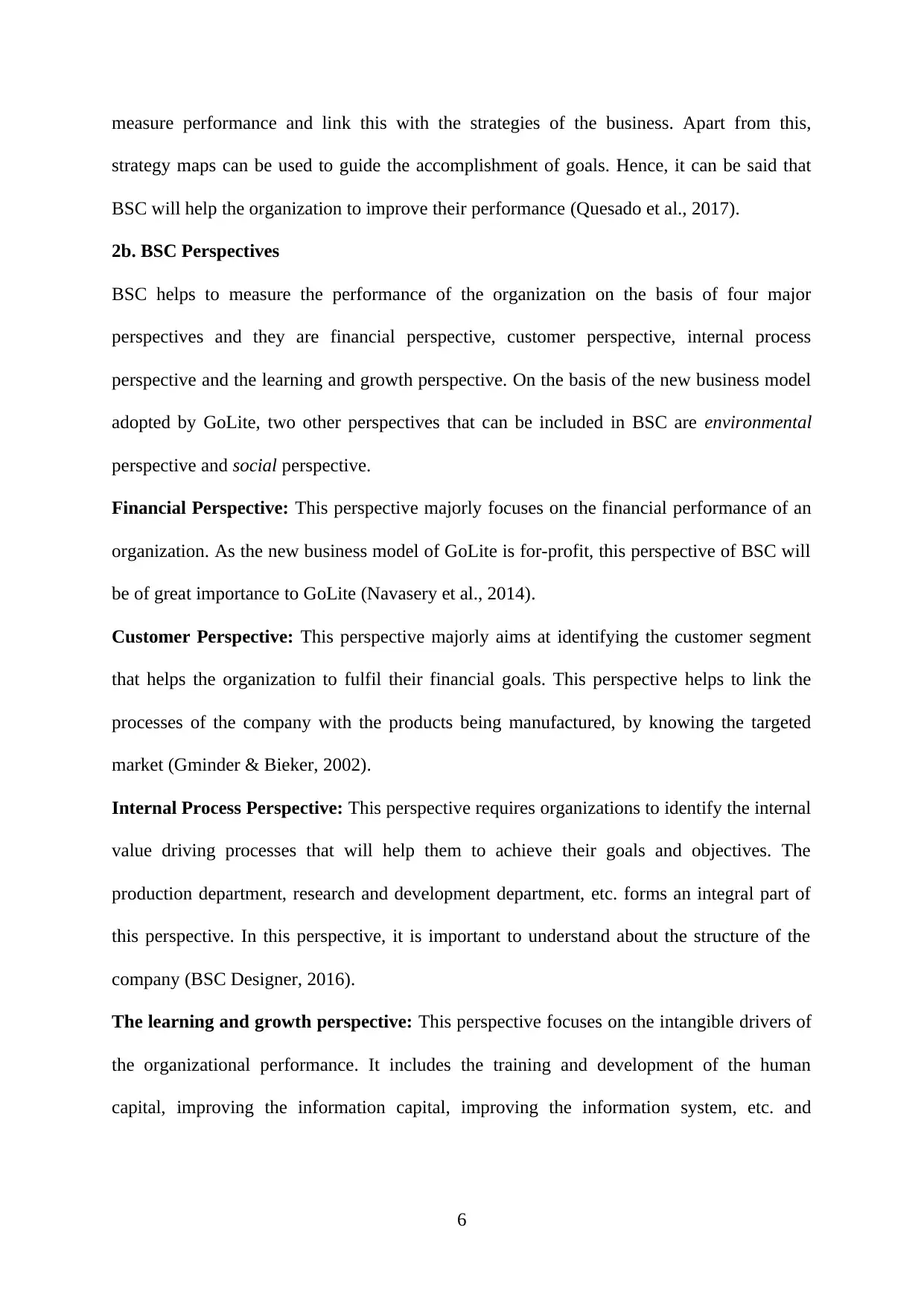
measure performance and link this with the strategies of the business. Apart from this,
strategy maps can be used to guide the accomplishment of goals. Hence, it can be said that
BSC will help the organization to improve their performance (Quesado et al., 2017).
2b. BSC Perspectives
BSC helps to measure the performance of the organization on the basis of four major
perspectives and they are financial perspective, customer perspective, internal process
perspective and the learning and growth perspective. On the basis of the new business model
adopted by GoLite, two other perspectives that can be included in BSC are environmental
perspective and social perspective.
Financial Perspective: This perspective majorly focuses on the financial performance of an
organization. As the new business model of GoLite is for-profit, this perspective of BSC will
be of great importance to GoLite (Navasery et al., 2014).
Customer Perspective: This perspective majorly aims at identifying the customer segment
that helps the organization to fulfil their financial goals. This perspective helps to link the
processes of the company with the products being manufactured, by knowing the targeted
market (Gminder & Bieker, 2002).
Internal Process Perspective: This perspective requires organizations to identify the internal
value driving processes that will help them to achieve their goals and objectives. The
production department, research and development department, etc. forms an integral part of
this perspective. In this perspective, it is important to understand about the structure of the
company (BSC Designer, 2016).
The learning and growth perspective: This perspective focuses on the intangible drivers of
the organizational performance. It includes the training and development of the human
capital, improving the information capital, improving the information system, etc. and
6
strategy maps can be used to guide the accomplishment of goals. Hence, it can be said that
BSC will help the organization to improve their performance (Quesado et al., 2017).
2b. BSC Perspectives
BSC helps to measure the performance of the organization on the basis of four major
perspectives and they are financial perspective, customer perspective, internal process
perspective and the learning and growth perspective. On the basis of the new business model
adopted by GoLite, two other perspectives that can be included in BSC are environmental
perspective and social perspective.
Financial Perspective: This perspective majorly focuses on the financial performance of an
organization. As the new business model of GoLite is for-profit, this perspective of BSC will
be of great importance to GoLite (Navasery et al., 2014).
Customer Perspective: This perspective majorly aims at identifying the customer segment
that helps the organization to fulfil their financial goals. This perspective helps to link the
processes of the company with the products being manufactured, by knowing the targeted
market (Gminder & Bieker, 2002).
Internal Process Perspective: This perspective requires organizations to identify the internal
value driving processes that will help them to achieve their goals and objectives. The
production department, research and development department, etc. forms an integral part of
this perspective. In this perspective, it is important to understand about the structure of the
company (BSC Designer, 2016).
The learning and growth perspective: This perspective focuses on the intangible drivers of
the organizational performance. It includes the training and development of the human
capital, improving the information capital, improving the information system, etc. and
6
You're viewing a preview
Unlock full access by subscribing today!
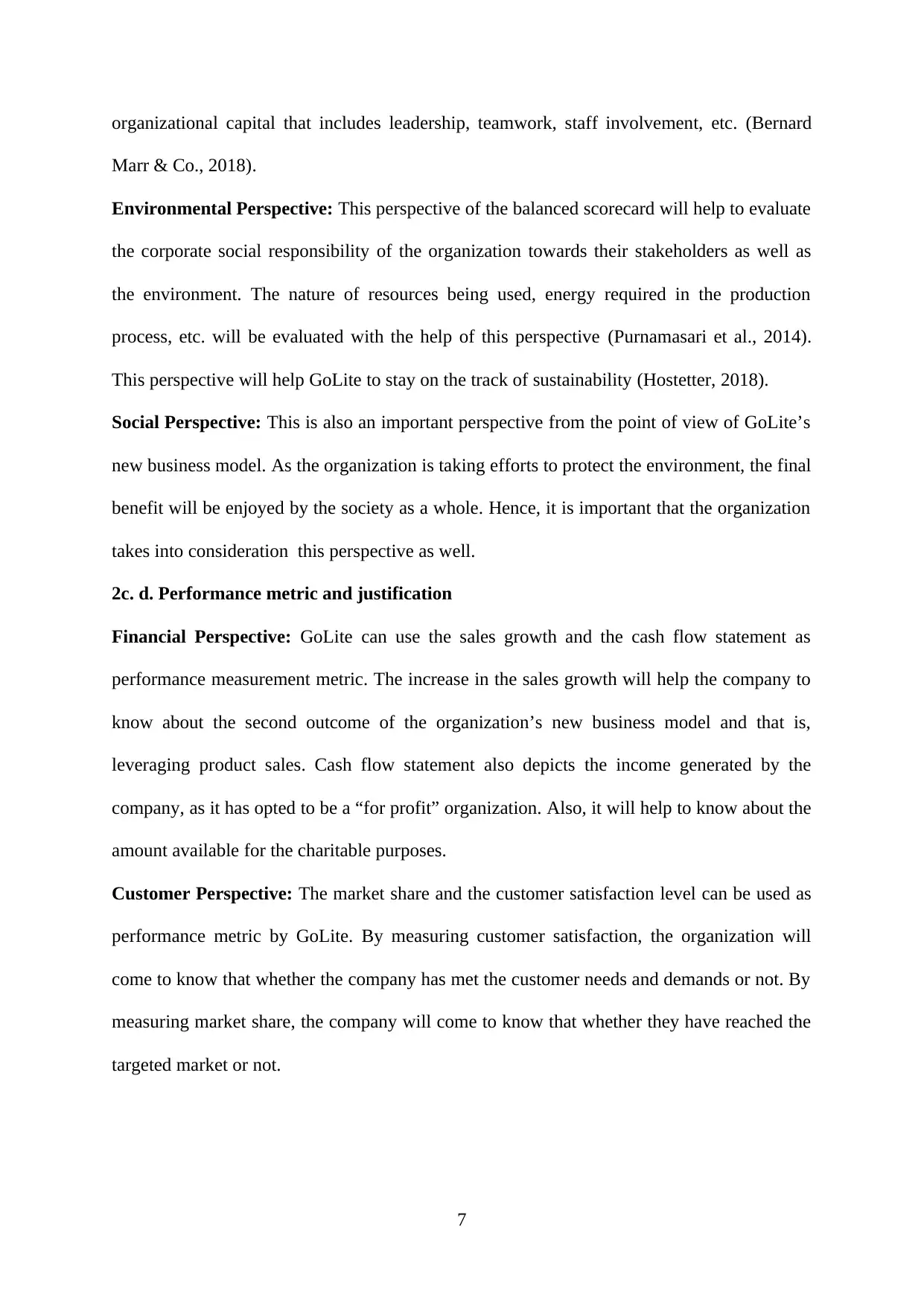
organizational capital that includes leadership, teamwork, staff involvement, etc. (Bernard
Marr & Co., 2018).
Environmental Perspective: This perspective of the balanced scorecard will help to evaluate
the corporate social responsibility of the organization towards their stakeholders as well as
the environment. The nature of resources being used, energy required in the production
process, etc. will be evaluated with the help of this perspective (Purnamasari et al., 2014).
This perspective will help GoLite to stay on the track of sustainability (Hostetter, 2018).
Social Perspective: This is also an important perspective from the point of view of GoLite’s
new business model. As the organization is taking efforts to protect the environment, the final
benefit will be enjoyed by the society as a whole. Hence, it is important that the organization
takes into consideration this perspective as well.
2c. d. Performance metric and justification
Financial Perspective: GoLite can use the sales growth and the cash flow statement as
performance measurement metric. The increase in the sales growth will help the company to
know about the second outcome of the organization’s new business model and that is,
leveraging product sales. Cash flow statement also depicts the income generated by the
company, as it has opted to be a “for profit” organization. Also, it will help to know about the
amount available for the charitable purposes.
Customer Perspective: The market share and the customer satisfaction level can be used as
performance metric by GoLite. By measuring customer satisfaction, the organization will
come to know that whether the company has met the customer needs and demands or not. By
measuring market share, the company will come to know that whether they have reached the
targeted market or not.
7
Marr & Co., 2018).
Environmental Perspective: This perspective of the balanced scorecard will help to evaluate
the corporate social responsibility of the organization towards their stakeholders as well as
the environment. The nature of resources being used, energy required in the production
process, etc. will be evaluated with the help of this perspective (Purnamasari et al., 2014).
This perspective will help GoLite to stay on the track of sustainability (Hostetter, 2018).
Social Perspective: This is also an important perspective from the point of view of GoLite’s
new business model. As the organization is taking efforts to protect the environment, the final
benefit will be enjoyed by the society as a whole. Hence, it is important that the organization
takes into consideration this perspective as well.
2c. d. Performance metric and justification
Financial Perspective: GoLite can use the sales growth and the cash flow statement as
performance measurement metric. The increase in the sales growth will help the company to
know about the second outcome of the organization’s new business model and that is,
leveraging product sales. Cash flow statement also depicts the income generated by the
company, as it has opted to be a “for profit” organization. Also, it will help to know about the
amount available for the charitable purposes.
Customer Perspective: The market share and the customer satisfaction level can be used as
performance metric by GoLite. By measuring customer satisfaction, the organization will
come to know that whether the company has met the customer needs and demands or not. By
measuring market share, the company will come to know that whether they have reached the
targeted market or not.
7
Paraphrase This Document
Need a fresh take? Get an instant paraphrase of this document with our AI Paraphraser
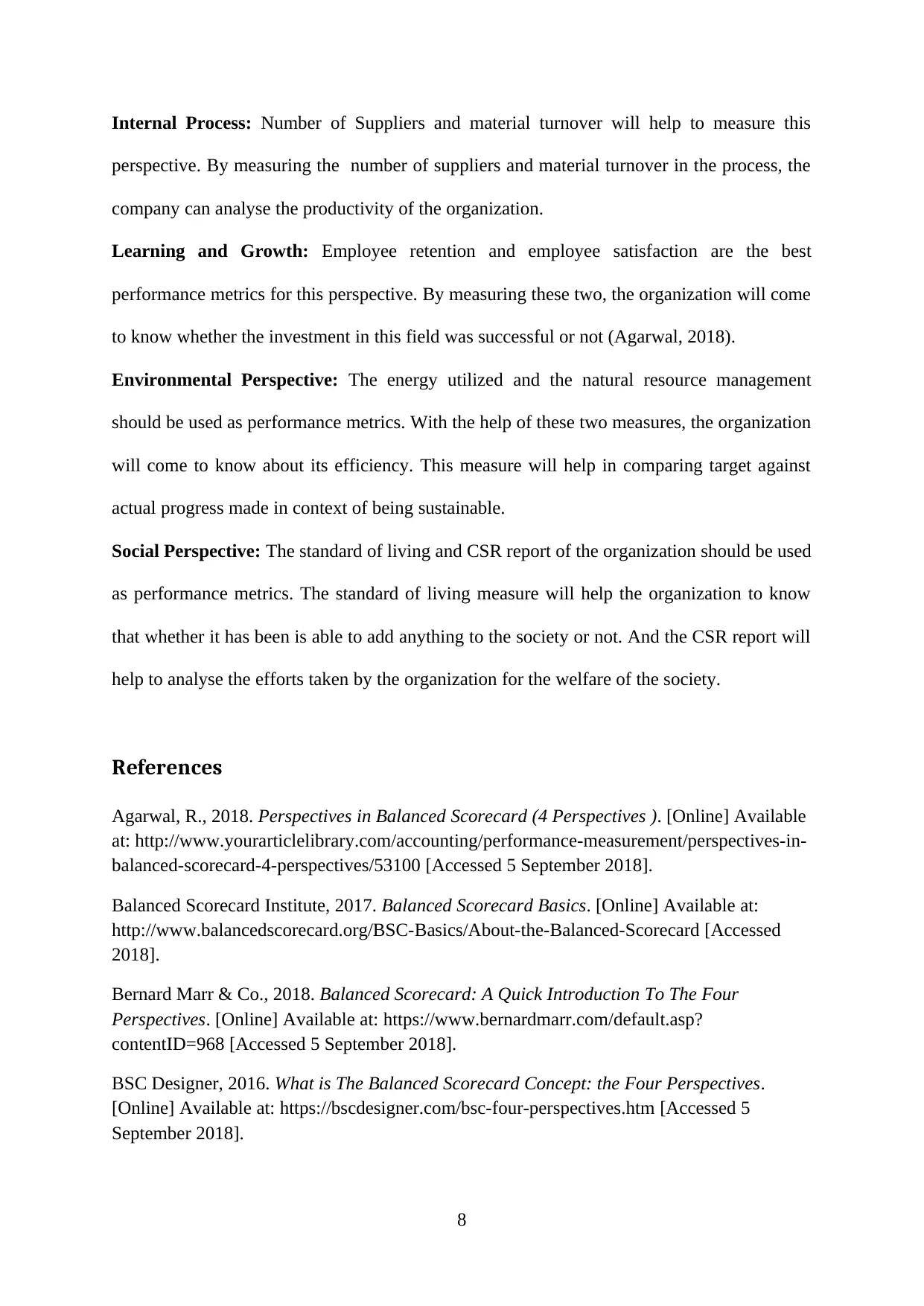
Internal Process: Number of Suppliers and material turnover will help to measure this
perspective. By measuring the number of suppliers and material turnover in the process, the
company can analyse the productivity of the organization.
Learning and Growth: Employee retention and employee satisfaction are the best
performance metrics for this perspective. By measuring these two, the organization will come
to know whether the investment in this field was successful or not (Agarwal, 2018).
Environmental Perspective: The energy utilized and the natural resource management
should be used as performance metrics. With the help of these two measures, the organization
will come to know about its efficiency. This measure will help in comparing target against
actual progress made in context of being sustainable.
Social Perspective: The standard of living and CSR report of the organization should be used
as performance metrics. The standard of living measure will help the organization to know
that whether it has been is able to add anything to the society or not. And the CSR report will
help to analyse the efforts taken by the organization for the welfare of the society.
References
Agarwal, R., 2018. Perspectives in Balanced Scorecard (4 Perspectives ). [Online] Available
at: http://www.yourarticlelibrary.com/accounting/performance-measurement/perspectives-in-
balanced-scorecard-4-perspectives/53100 [Accessed 5 September 2018].
Balanced Scorecard Institute, 2017. Balanced Scorecard Basics. [Online] Available at:
http://www.balancedscorecard.org/BSC-Basics/About-the-Balanced-Scorecard [Accessed
2018].
Bernard Marr & Co., 2018. Balanced Scorecard: A Quick Introduction To The Four
Perspectives. [Online] Available at: https://www.bernardmarr.com/default.asp?
contentID=968 [Accessed 5 September 2018].
BSC Designer, 2016. What is The Balanced Scorecard Concept: the Four Perspectives.
[Online] Available at: https://bscdesigner.com/bsc-four-perspectives.htm [Accessed 5
September 2018].
8
perspective. By measuring the number of suppliers and material turnover in the process, the
company can analyse the productivity of the organization.
Learning and Growth: Employee retention and employee satisfaction are the best
performance metrics for this perspective. By measuring these two, the organization will come
to know whether the investment in this field was successful or not (Agarwal, 2018).
Environmental Perspective: The energy utilized and the natural resource management
should be used as performance metrics. With the help of these two measures, the organization
will come to know about its efficiency. This measure will help in comparing target against
actual progress made in context of being sustainable.
Social Perspective: The standard of living and CSR report of the organization should be used
as performance metrics. The standard of living measure will help the organization to know
that whether it has been is able to add anything to the society or not. And the CSR report will
help to analyse the efforts taken by the organization for the welfare of the society.
References
Agarwal, R., 2018. Perspectives in Balanced Scorecard (4 Perspectives ). [Online] Available
at: http://www.yourarticlelibrary.com/accounting/performance-measurement/perspectives-in-
balanced-scorecard-4-perspectives/53100 [Accessed 5 September 2018].
Balanced Scorecard Institute, 2017. Balanced Scorecard Basics. [Online] Available at:
http://www.balancedscorecard.org/BSC-Basics/About-the-Balanced-Scorecard [Accessed
2018].
Bernard Marr & Co., 2018. Balanced Scorecard: A Quick Introduction To The Four
Perspectives. [Online] Available at: https://www.bernardmarr.com/default.asp?
contentID=968 [Accessed 5 September 2018].
BSC Designer, 2016. What is The Balanced Scorecard Concept: the Four Perspectives.
[Online] Available at: https://bscdesigner.com/bsc-four-perspectives.htm [Accessed 5
September 2018].
8
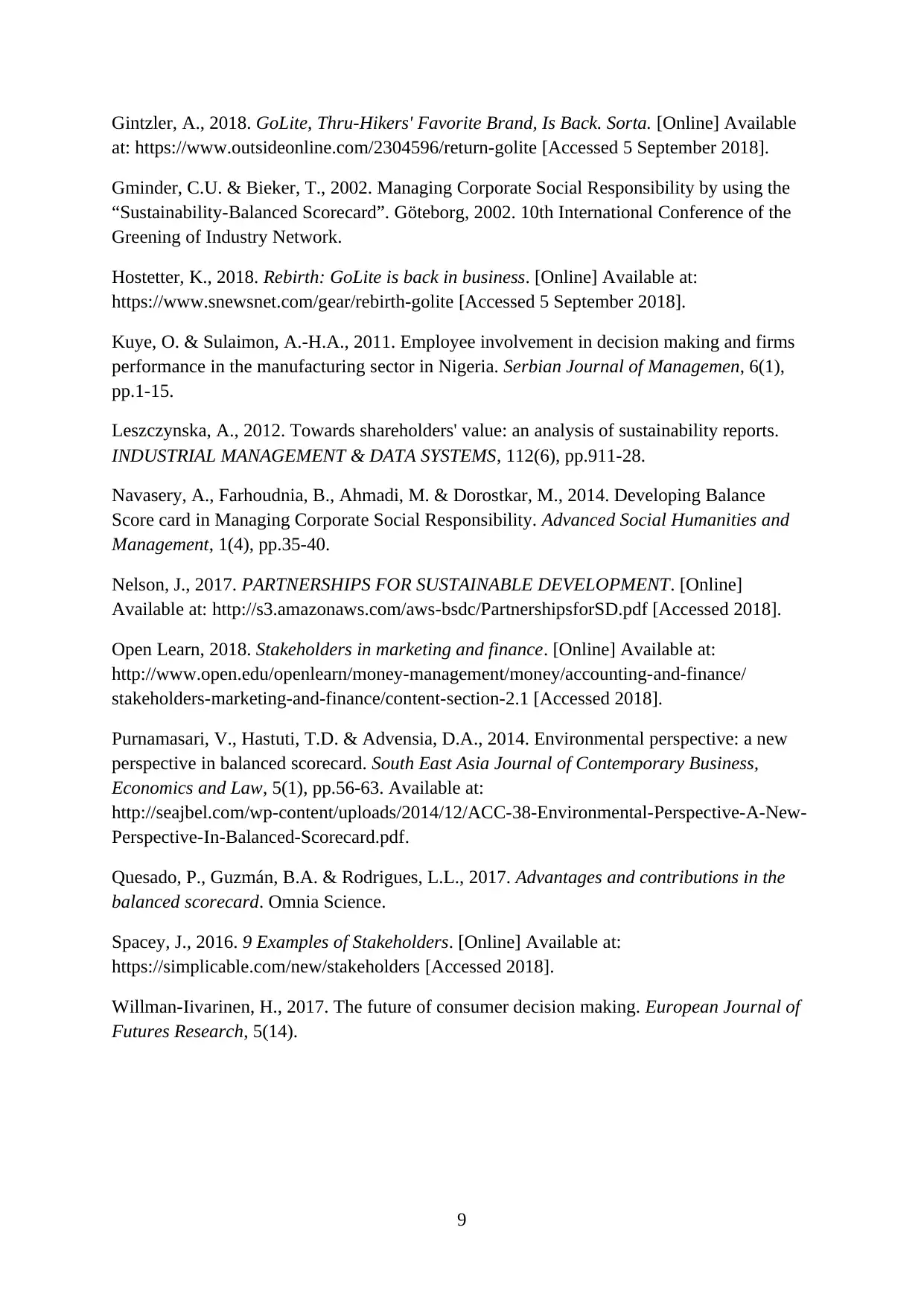
Gintzler, A., 2018. GoLite, Thru-Hikers' Favorite Brand, Is Back. Sorta. [Online] Available
at: https://www.outsideonline.com/2304596/return-golite [Accessed 5 September 2018].
Gminder, C.U. & Bieker, T., 2002. Managing Corporate Social Responsibility by using the
“Sustainability-Balanced Scorecard”. Göteborg, 2002. 10th International Conference of the
Greening of Industry Network.
Hostetter, K., 2018. Rebirth: GoLite is back in business. [Online] Available at:
https://www.snewsnet.com/gear/rebirth-golite [Accessed 5 September 2018].
Kuye, O. & Sulaimon, A.-H.A., 2011. Employee involvement in decision making and firms
performance in the manufacturing sector in Nigeria. Serbian Journal of Managemen, 6(1),
pp.1-15.
Leszczynska, A., 2012. Towards shareholders' value: an analysis of sustainability reports.
INDUSTRIAL MANAGEMENT & DATA SYSTEMS, 112(6), pp.911-28.
Navasery, A., Farhoudnia, B., Ahmadi, M. & Dorostkar, M., 2014. Developing Balance
Score card in Managing Corporate Social Responsibility. Advanced Social Humanities and
Management, 1(4), pp.35-40.
Nelson, J., 2017. PARTNERSHIPS FOR SUSTAINABLE DEVELOPMENT. [Online]
Available at: http://s3.amazonaws.com/aws-bsdc/PartnershipsforSD.pdf [Accessed 2018].
Open Learn, 2018. Stakeholders in marketing and finance. [Online] Available at:
http://www.open.edu/openlearn/money-management/money/accounting-and-finance/
stakeholders-marketing-and-finance/content-section-2.1 [Accessed 2018].
Purnamasari, V., Hastuti, T.D. & Advensia, D.A., 2014. Environmental perspective: a new
perspective in balanced scorecard. South East Asia Journal of Contemporary Business,
Economics and Law, 5(1), pp.56-63. Available at:
http://seajbel.com/wp-content/uploads/2014/12/ACC-38-Environmental-Perspective-A-New-
Perspective-In-Balanced-Scorecard.pdf.
Quesado, P., Guzmán, B.A. & Rodrigues, L.L., 2017. Advantages and contributions in the
balanced scorecard. Omnia Science.
Spacey, J., 2016. 9 Examples of Stakeholders. [Online] Available at:
https://simplicable.com/new/stakeholders [Accessed 2018].
Willman-Iivarinen, H., 2017. The future of consumer decision making. European Journal of
Futures Research, 5(14).
9
at: https://www.outsideonline.com/2304596/return-golite [Accessed 5 September 2018].
Gminder, C.U. & Bieker, T., 2002. Managing Corporate Social Responsibility by using the
“Sustainability-Balanced Scorecard”. Göteborg, 2002. 10th International Conference of the
Greening of Industry Network.
Hostetter, K., 2018. Rebirth: GoLite is back in business. [Online] Available at:
https://www.snewsnet.com/gear/rebirth-golite [Accessed 5 September 2018].
Kuye, O. & Sulaimon, A.-H.A., 2011. Employee involvement in decision making and firms
performance in the manufacturing sector in Nigeria. Serbian Journal of Managemen, 6(1),
pp.1-15.
Leszczynska, A., 2012. Towards shareholders' value: an analysis of sustainability reports.
INDUSTRIAL MANAGEMENT & DATA SYSTEMS, 112(6), pp.911-28.
Navasery, A., Farhoudnia, B., Ahmadi, M. & Dorostkar, M., 2014. Developing Balance
Score card in Managing Corporate Social Responsibility. Advanced Social Humanities and
Management, 1(4), pp.35-40.
Nelson, J., 2017. PARTNERSHIPS FOR SUSTAINABLE DEVELOPMENT. [Online]
Available at: http://s3.amazonaws.com/aws-bsdc/PartnershipsforSD.pdf [Accessed 2018].
Open Learn, 2018. Stakeholders in marketing and finance. [Online] Available at:
http://www.open.edu/openlearn/money-management/money/accounting-and-finance/
stakeholders-marketing-and-finance/content-section-2.1 [Accessed 2018].
Purnamasari, V., Hastuti, T.D. & Advensia, D.A., 2014. Environmental perspective: a new
perspective in balanced scorecard. South East Asia Journal of Contemporary Business,
Economics and Law, 5(1), pp.56-63. Available at:
http://seajbel.com/wp-content/uploads/2014/12/ACC-38-Environmental-Perspective-A-New-
Perspective-In-Balanced-Scorecard.pdf.
Quesado, P., Guzmán, B.A. & Rodrigues, L.L., 2017. Advantages and contributions in the
balanced scorecard. Omnia Science.
Spacey, J., 2016. 9 Examples of Stakeholders. [Online] Available at:
https://simplicable.com/new/stakeholders [Accessed 2018].
Willman-Iivarinen, H., 2017. The future of consumer decision making. European Journal of
Futures Research, 5(14).
9
You're viewing a preview
Unlock full access by subscribing today!
1 out of 9
Related Documents
Your All-in-One AI-Powered Toolkit for Academic Success.
+13062052269
info@desklib.com
Available 24*7 on WhatsApp / Email
![[object Object]](/_next/static/media/star-bottom.7253800d.svg)
Unlock your academic potential
© 2024 | Zucol Services PVT LTD | All rights reserved.





